Vinery is one of the most extended agricultural activities in the world with more than 60 million tons of grapes produced globally every year (Teixeira et al., 2014). Apart from the byproducts generated from the direct production of wine such as grape stalks, seeds, skins or grape marc, vine shoots are other byproducts that are generated in high quantities, from 2-4 tons per hectare (Nabais et al., 2010). Conventionally, vine shoots are left on the ground to root or used as energy source. However the combustion of vine shoots produces toxic compounds such as benzopyrene, catechol or naphthalene, which cause environmental and ecological problems and can also be a risk for the human health (Max et al., 2009). In order to decrease the problems generated by these residues and to reduce their accumulation, research has been carried out to revalorize the vine shoots. As they are a lignocellulosic material, research has been focused on their application in the preparation of paper pulp (Jimenez et al., 2004), as a source of polyphenols (Max et al., 2010) or as a source of renewable sugars, which can be converted to a variety of products, such as lactic acid and xylitol (Rivas et al., 2006). The obtaining of sugars from these residues has been carried by hydrothermal pretreatments. However the use of this pretreatment on vine shoots for the extraction of oligosaccharides has not been exploited yet. The interest in oligosaccharides has increased since apart from being used as food ingredients, due to their prebiotic effects derived from their ability to modulate the intestinal function, they present multiple biological activities such as immunity enhancement, facilitation of mineral absorption, antioxidant activity, antibiotic alternative, regulators of blood glucose in diabetics and serum lipids in hyperlipidemics (Moure et al., 2006). Considering these premises, the aim of this work was to determine the optimal conditions of autohydrolysis that permits the maximum solubilization of hemicelluloses, with the maximum yield of oligosaccharides and with the minimum formation of monosaccharides and degradation products.
Experimental
Raw material. Vine shoots from the grape variety Hondarribi Zuri, kindly supplied by the winery Aldako Bodegas S.L. (Oiartzun, Spain), were milled and sieved for a particle size smaller than 0.4 mm.
Analysis of raw material. The chemical composition of the vine shoots was analyzed following standard methods; moisture (TAPPI T264-om-88), ashes (TAPPI T244-om-93) and ethanol-toluene extractives (TAPPI T204 cm-97) were determined. The content of hemicelluloses and cellulose was quantified by a quantitative acid hydrolysis with H2SO4 72% (TAPPI T-249-em-85) and the solid residue obtained after the hydrolysis was considered as Klason lignin.
Autohydrolysis processing. The solubilization of the hemicelluloses was carried out by autohydrolysis in a 1.5 L Parr reactor under non-isothermal conditions using a solid/liquid ratio 8 kg/kg (oven dry basis). The autohydrolysis treatments were carried out at several temperatures from 180-215ºC and once the target temperature was achieved, the reaction media was cooled and the liquors were recovered by filtration. The solid phase was washed and air dried to measure the solid yield, while the liquid phase was processed as follows.
Analysis of autohydrolysis liquors. An aliquot of the liquid phase was oven-dried at 104 ± 4 ºC until constant weight, to determine the non-volatile content (NVC). Another aliquot of the liquid phase was used for direct HPLC determination of glucose, xylose, arabinose, galacturonic acid, acetic acid, furfural and 5-hydroxymethyl furfural. The third aliquot was subjected to quantitative posthydrolysis (4% H2SO4 for 20 min at 121ºC) before HPLC analysis. The increase in the concentration of the monosaccharides observed after the quantitative posthydrolysis corresponded to the concentration of oligosaccharides.
Results and discussion
Composition of the vine shoots. Figure 1 represents the compositional data concerning to the vine shoots of the variety used in this work.
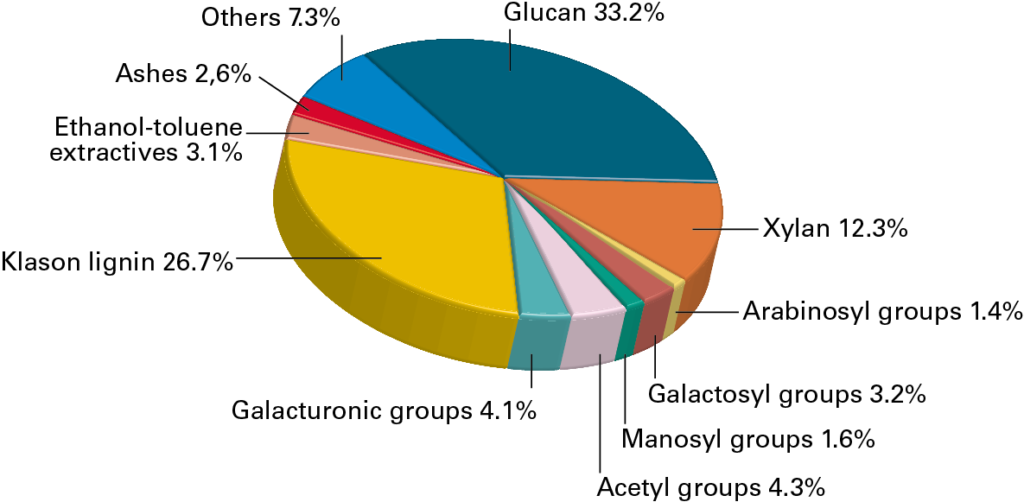
Effects of the autohydrolysis treatments on the composition of liquid phases. The effect that the temperature of the autohydrolysis treatments exerts in the obtaining of oligosaccharides was determined by analyzing the composition of the liquors. As the temperature of the treatment increases, the conditions become harder, producing a higher solubilization of the raw material. The solubilization increases until 200ºC (38.7%) then it remains almost constant only increasing a 2.4% for the hardest conditions. The decrease in the weight of the raw material occurs mainly because of the solubilization of the hemicelluloses. The hydrolysate contains non-volatile compounds (NVC) (monosaccharides, oligosaccharides and impurities or other non-volatile compounds (ONVC)) and volatile compounds (VC) (acetic acid, furfural and hydroxymethyl furfural). The NVC increases with the temperature until reaching 0.033 g NVC/g liquor for 200ºC, then as the conditions of the treatment become harsher the concentration of these compounds start to decrease being a 0.025 g NVC/g liquor at 215ºC. This can be explained considering that at 200ºC the main contribution to the NVC are the oligosaccharides which at higher temperature may start to decompose (Martínez et al., 2009). This is in agreement with the evidence that the liquors obtained when the autohydrolysis was carried at 200ºC presents the higher content of oligosaccharides (28.43 g oligosaccharides/L), as it can be seen in Figure 2.
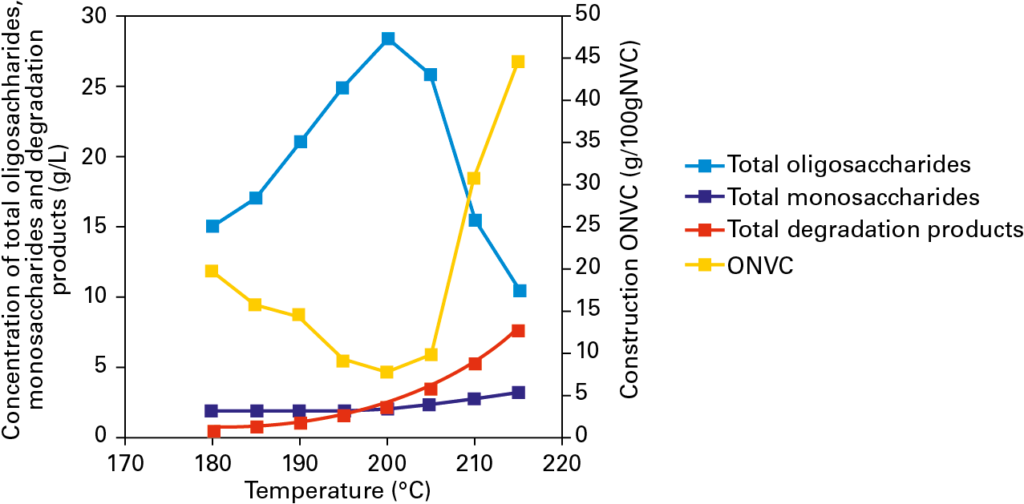
The concentration of monosaccharides in the liquors increases slightly with the temperature from 1.84 g/L at 180ºC to 3.23 g/L at 215ºC. The concentration of the monosaccharides in the liquor obtained at 20ºC is of 2.02 g/L. The VC in the liquors increases with the temperatures reaching a 19.7% of the conversion of the raw material at the harshest conditions. This reflects the fact that the number of decomposition reactions increases with the temperature, favoring the formation of degradation products, as it can be seen in Figure 2. The concentration of ONVC in the liquors decreases until 200ºC, temperature at which it reaches its minimum (0.08 g/gr NVC). Afterwards, with the increase of the temperatures it continues to increase reaching a maximum of 0.45 g/g NVC at the harshest conditions.
Conclusions
From the work carried out it can be concluded that the autohydrolysis treatment is a suitable approach to obtain substituted oligosaccharides from vine shoots. It was also observed that the temperature of autohydrolysis that permits the maximum obtaining of oligosaccharides was 200ºC. The liquor obtained at this temperature presents the higher oligosaccharide content (28.43 g/L), with quite low content of monosaccharides (0.22 g/l) and degradation products (2.34 g/L). Further treatment could be carried out to increase the ratio of oligosaccharides and decrease the ONVC fraction in the obtained liquors.
By Izaskun Davila-Rodriguez1*, Patricia Gullón1, Itziar Egües1, Jalel Labidi1. 1Chemical Engineering and environmental department, University of the Basque Country, Donostia-San Sebastian, Spain * idavilarodriguez@hotmail.com
Acknowledgements – The authors would like to thank the Department of Agriculture, Fishing and Food of the Basque Government (scholarship of young researchers training), the Spanish Government (contract for postdoctoral formation) and the University of the Basque Country (Postdoctoral fellow ESPDOC14/003).
References
Jimenez, L., Angulo, V., Garcia, E., and Rodriguez, A., 2004. Cellulosic pulp from vine shoots. Afinidad 61(511), 194-203
Martínez, M., Gullón, B., Schols, H.A., Alonso, J.L., Parajó, J.C., 2009. Assessment of the Production of Oligomeric Compounds from Sugar Beet Pulp. Industrial and Engineering Chemistry Research 48, 4681-4687
Max, B., Salgado, J.M., Cortés, S., Domínguez, J.M., 2010. Extraction of Phenolic Acids by Alkaline Hydrolysis from the Solid Residue Obtained after Prehydrolysis of Trimming Vine Shoots. Journal of Agricultural and Food Chemistry 58, 1909-1917
Max, B., Torrado, A.M., Moldes, A.B., Converti, A., Dominguez, J.M. 2009. Ferulic acid and p-coumaric acid solubilization by alkaline hydrolysis of the solid residue obtained after acid prehydrolysis of vine shoot prunings: effect of the hydroxide and pH. Biochemical Engineering Journal 43, 129-134
Moure, A., Gullón, P., Domínguez, H., Parajó, J.C., 2006. Advances in the Manufacture, Purification and Applications of Xylo-Oligosaccharides as Food Additives and Nutraceuticals. Process Biochemistry 41, 1913-1923
Nabais, J.M.V., Laginhas, C., Carrott, P.J.M., Carrott, M.M.L.R., 2010. Thermal conversion of a novel biomass agricultural residue (vine shoots) into activated carbon using activation with CO2. Journal of Analytical and Applied Pyrolysis 87, 8-13
Rivas, B., Torrado, A., Rivas, S., Moldes, A.B., Dominguez, J.M., 2007. Simultaneous lactic acid and xylitol production from vine trimming wastesJournal of the Science of Food and Agriculture 87, 1603-1612
Teixeira, A., Baenas, N., Dominguez-Perles, R., Barros, A., Rosa, E., Moreno, D.A., Garcia-Viguera, C., 2014. Natural Bioactive Compounds from Winery By-Products as Health Promoters: A Review, International Journal of Molecular Science 15, 15638-15678

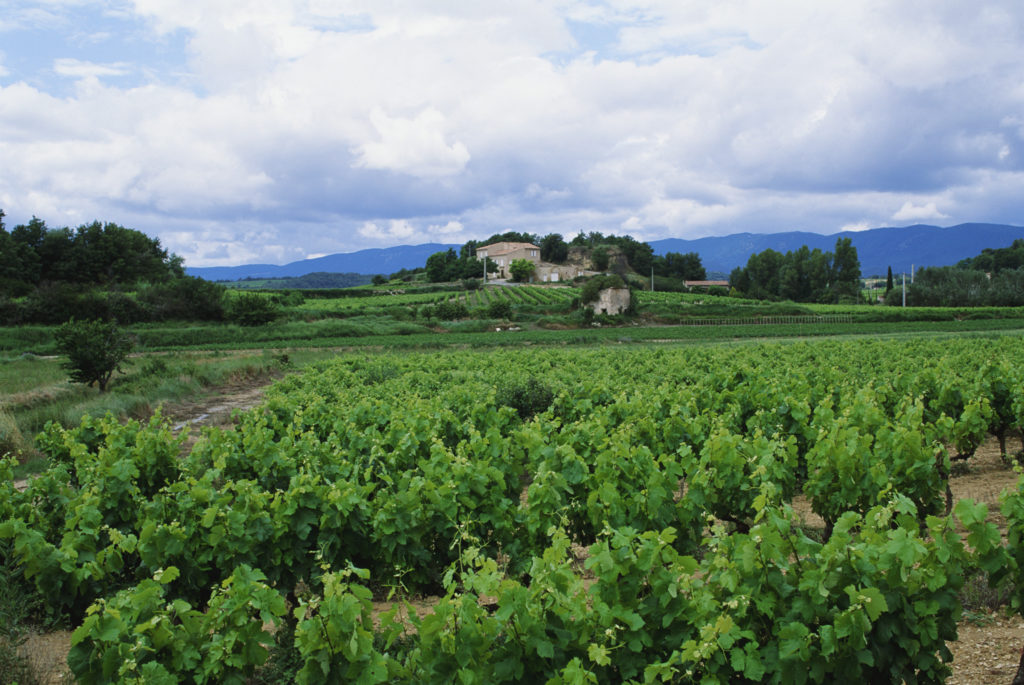
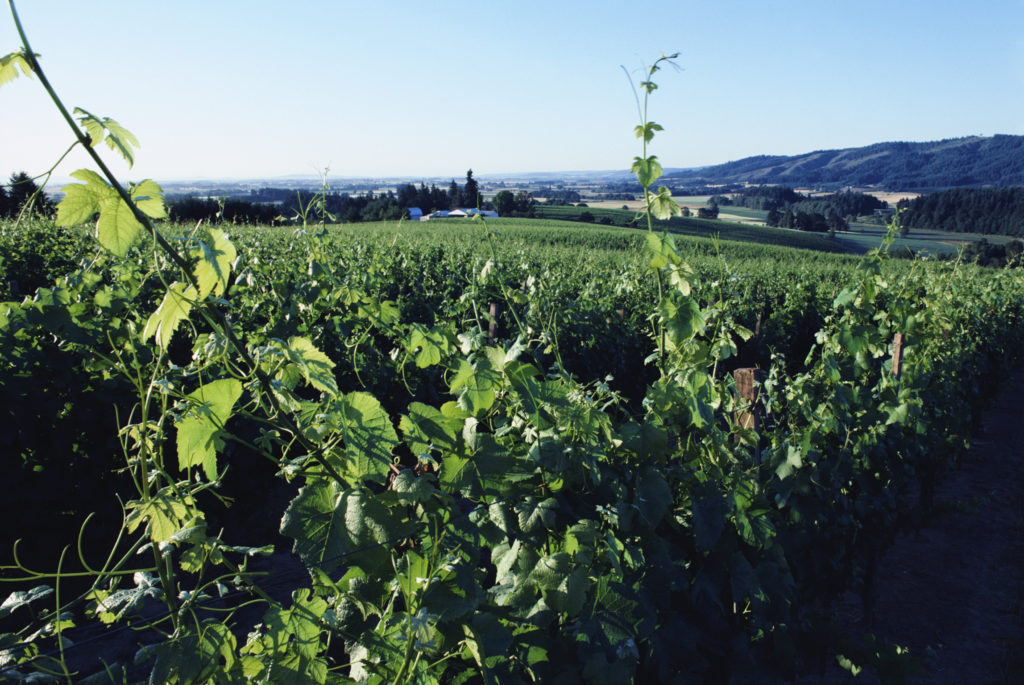

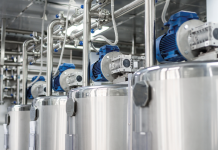
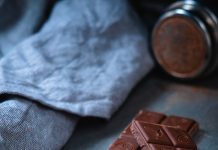
[…] Consulta alcuni articoli: Fresh pasta, versatility and automation for a high-quality product; Refining systems, a delicate operation; Manufacture of oligosaccharides from vine shoots by bio-refinery approach […]
Comments are closed.